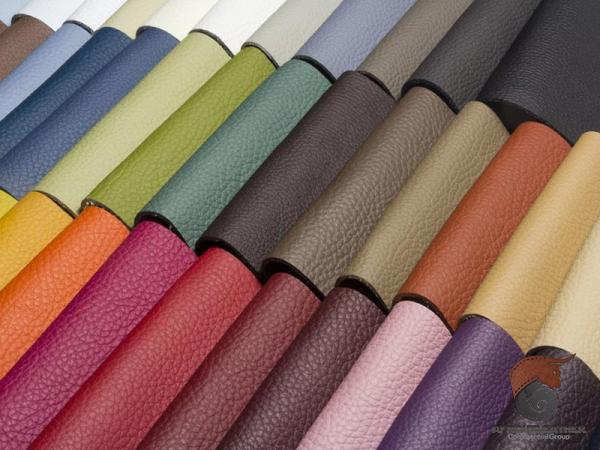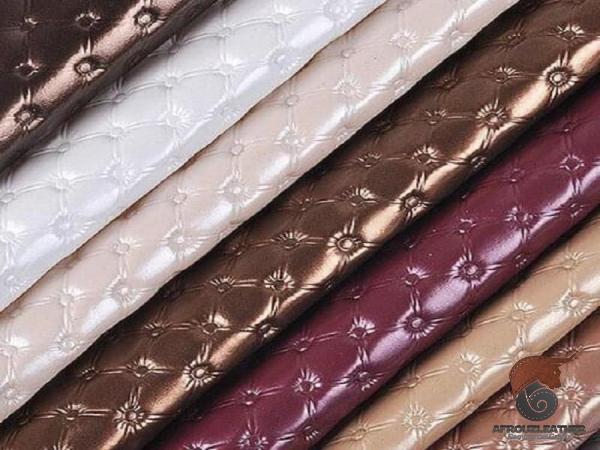With the rising demand for ethical and sustainable alternatives to traditional leather, synthetic leather, also known as faux leather or pleather, has emerged as a viable alternative. This article explores the various aspects of synthetic leather, including its production process, key features, applications, advantages, and environmental impact. Synthetic leather is a material that replicates the look and feel of genuine leather while offering several unique advantages, making it a popular choice among consumers and businesses alike. 1. Production Process: Synthetic leather is primarily made from a polyurethane (PU) or polyvinyl chloride (PVC) base, which is then coated with various additives and treatments to mimic the texture, appearance, and durability of real leather. The production process involves multiple stages, including backing, coating, embossing, and finishing, to create a material that closely resembles genuine leather.
leather
 Additionally, recent advances in technology have led to the development of bio-based synthetic leather, which utilizes natural, plant-derived materials as the base components. 2. Features of Synthetic Leather: Synthetic leather possesses several notable features that make it an attractive alternative to genuine leather. These features include its affordability, durability, versatility, and easy maintenance. Unlike real leather, synthetic leather is less susceptible to wear and tear, is resistant to stains and fading, and offers a consistent quality across a wide range of products. It also provides designers and manufacturers with greater flexibility, as it can be easily customized and produced in various colors, textures, and finishes to suit different applications. 3. Applications: Synthetic leather finds extensive usage across numerous industries and product categories. It is commonly used in the automotive industry for upholstery, seat covers, and steering wheel covers, as well as in the fashion industry for clothing items, accessories, and footwear. Synthetic leather also plays a crucial role in the furniture industry, where it is used for upholstery, sofas, chairs, and headrests.
Additionally, recent advances in technology have led to the development of bio-based synthetic leather, which utilizes natural, plant-derived materials as the base components. 2. Features of Synthetic Leather: Synthetic leather possesses several notable features that make it an attractive alternative to genuine leather. These features include its affordability, durability, versatility, and easy maintenance. Unlike real leather, synthetic leather is less susceptible to wear and tear, is resistant to stains and fading, and offers a consistent quality across a wide range of products. It also provides designers and manufacturers with greater flexibility, as it can be easily customized and produced in various colors, textures, and finishes to suit different applications. 3. Applications: Synthetic leather finds extensive usage across numerous industries and product categories. It is commonly used in the automotive industry for upholstery, seat covers, and steering wheel covers, as well as in the fashion industry for clothing items, accessories, and footwear. Synthetic leather also plays a crucial role in the furniture industry, where it is used for upholstery, sofas, chairs, and headrests.
Specifications of leather
 Additionally, it is an essential material in the manufacturing of bags, wallets, belts, and various other consumer goods. 4. Advantages of Synthetic Leather: a. Sustainability: One of the key advantages of synthetic leather is its reduced environmental impact compared to genuine leather. Synthetic leather production eliminates the need for animal hides, minimizing the ecological footprint associated with livestock farming and tanning processes. Furthermore, advancements in eco-friendly materials have enhanced the sustainability of synthetic leather, with bio-based alternatives offering even greater environmental benefits. b. Affordability: Synthetic leather is significantly more affordable than genuine leather, making it a cost-effective choice for both consumers and businesses. This affordability enables increased accessibility to products that feature the look and feel of high-quality leather without the premium price tag. c. Durability and Maintenance: Synthetic leather is highly durable and resistant to most forms of damage, including scratches, tears, and discoloration.
Additionally, it is an essential material in the manufacturing of bags, wallets, belts, and various other consumer goods. 4. Advantages of Synthetic Leather: a. Sustainability: One of the key advantages of synthetic leather is its reduced environmental impact compared to genuine leather. Synthetic leather production eliminates the need for animal hides, minimizing the ecological footprint associated with livestock farming and tanning processes. Furthermore, advancements in eco-friendly materials have enhanced the sustainability of synthetic leather, with bio-based alternatives offering even greater environmental benefits. b. Affordability: Synthetic leather is significantly more affordable than genuine leather, making it a cost-effective choice for both consumers and businesses. This affordability enables increased accessibility to products that feature the look and feel of high-quality leather without the premium price tag. c. Durability and Maintenance: Synthetic leather is highly durable and resistant to most forms of damage, including scratches, tears, and discoloration.
buy leather
 Moreover, it is easier to clean and maintain than genuine leather, as it does not require specialized cleaners or conditioning products. Simply wiping synthetic leather with a damp cloth is usually sufficient to keep it looking pristine. d. Customization: Synthetic leather offers unparalleled customization possibilities, allowing for a wide range of colors, textures, and finishes to be incorporated into products. Manufacturers can create unique designs in line with changing fashion trends or specific customer preferences. This versatility greatly enhances the appeal of synthetic leather in the fashion and interior design industries. 5. Environmental Impact: While synthetic leather offers various sustainability benefits, it is important to note that its production still involves the use of synthetic materials derived from fossil fuels. The use of PVC in particular raises concerns due to its potential environmental and health impacts. However, advancements in bio-based and eco-friendly alternatives are helping address these concerns by reducing the reliance on finite resources and hazardous chemicals. As technology continues to advance, the environmental impact of synthetic leather can be further mitigated. Conclusion: Synthetic leather has gained significant popularity as a sustainable and versatile alternative to genuine leather. With its ability to replicate the look and feel of real leather while offering numerous advantages, synthetic leather has found its place across various industries and product categories. As sustainable practices and eco-friendly materials continue to evolve, the future of synthetic leather holds promise for a reduced environmental footprint, making it an even more attractive option for both consumers and businesses alike.
Moreover, it is easier to clean and maintain than genuine leather, as it does not require specialized cleaners or conditioning products. Simply wiping synthetic leather with a damp cloth is usually sufficient to keep it looking pristine. d. Customization: Synthetic leather offers unparalleled customization possibilities, allowing for a wide range of colors, textures, and finishes to be incorporated into products. Manufacturers can create unique designs in line with changing fashion trends or specific customer preferences. This versatility greatly enhances the appeal of synthetic leather in the fashion and interior design industries. 5. Environmental Impact: While synthetic leather offers various sustainability benefits, it is important to note that its production still involves the use of synthetic materials derived from fossil fuels. The use of PVC in particular raises concerns due to its potential environmental and health impacts. However, advancements in bio-based and eco-friendly alternatives are helping address these concerns by reducing the reliance on finite resources and hazardous chemicals. As technology continues to advance, the environmental impact of synthetic leather can be further mitigated. Conclusion: Synthetic leather has gained significant popularity as a sustainable and versatile alternative to genuine leather. With its ability to replicate the look and feel of real leather while offering numerous advantages, synthetic leather has found its place across various industries and product categories. As sustainable practices and eco-friendly materials continue to evolve, the future of synthetic leather holds promise for a reduced environmental footprint, making it an even more attractive option for both consumers and businesses alike.

Your comment submitted.